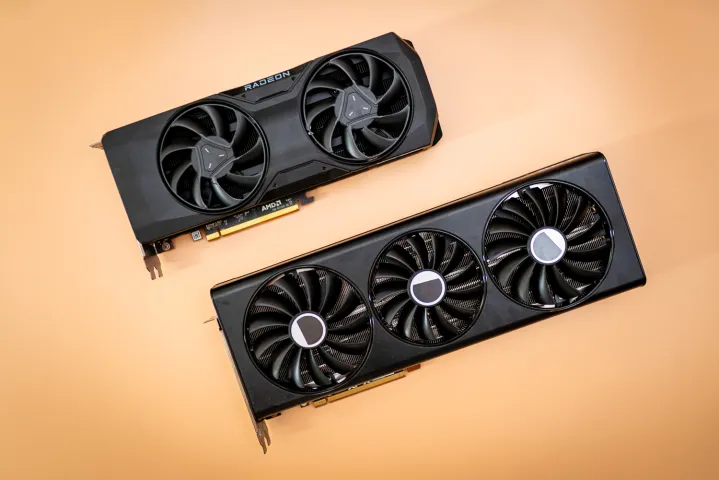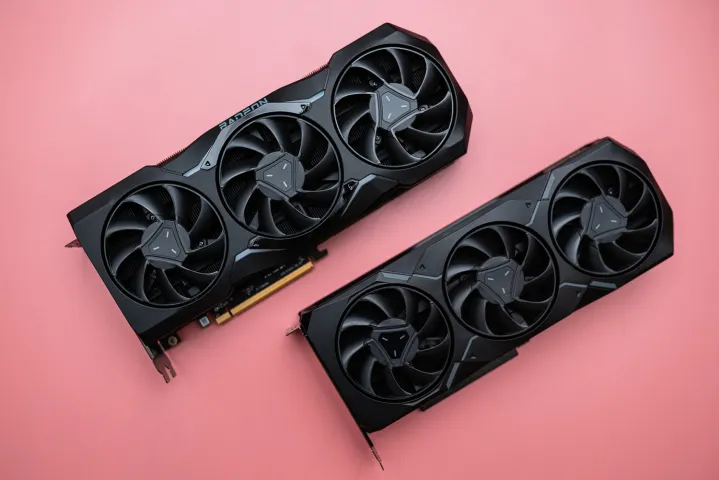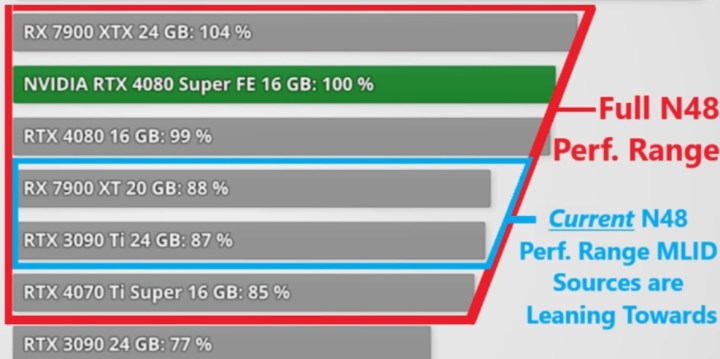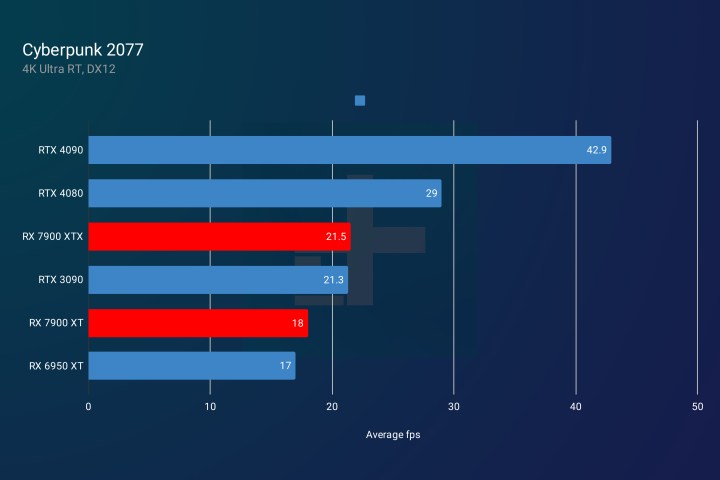AMD RDNA 4: All of the information currently available regarding the RX 8000 series
Although they're still a little mysterious, AMD's RDNA 4 graphics cards—also known as the Radeon RX 8000 series—are already anticipated. Thankfully, a number of leakers punctuate AMD's lack of statement regarding its upcoming GPUs with a wealth of rumors and intriguing conjecture.
The information that we currently know about AMD's RDNA 4's specifications comes from leaks. While there are some information overlaps from different sources, Tom of Moore's Law Is Dead on YouTube provides the most of the specs information. According to the YouTuber's current predictions, AMD will only ship RDNA 4 in Navi 48 and Navi 44 configurations.
The one thing that is widely agreed upon and has been discussed for months is that AMD's upcoming GPUs will not have the specifications required to compete with Nvidia's top-tier GPUs, such as the RTX 5090. The middle market is AMD's focus, as suggested by the speculative details of both CPUs.
The Navi 48, which may be found in an RX 8800 XT GPU, will be AMD's flagship chip for this generation, according to Moore's Law Is Dead. According to preliminary estimations, this GPU has a 256-bit interface and 20Gbps of GDDR6 memory. Additionally, given that some leakers have indicated that it might include a 192-bit bus, this possibility exists. There are rumors about a 128-bit memory bus and a much smaller die on the Navi 44 GPU.
Given that Nvidia's next-generation GPUs are rumored to be employing the faster and more recent GDDR7 standard, the decision to use GDDR6 rather than GDDR7 may appear odd. According to Moore's Law Is Dead, AMD may have originally intended to employ GDDR7 RAM in the Navi 41 (or Navi 4C and Navi 4X) and Navi 42, the now-reportedly-canceled high-end segment of the range. If the Navi 41 had been produced, it would have replaced the RX 7900 XTX. All midrange to entry-level cards, though, are rumored to use GDDR6 memory.
Indeed, according to recent claims from Kepler_L2 and Tom's Hardware, AMD might limit bandwidth and employ 18Gbps modules rather than the faster 20Gbps versions that have been seen in RDNA 3 flagships. AMD might also continue to use GDDR6 modules. This would be a downgrade because 19.5Gbps modules are even used by the RX 7800 XT. However, it's crucial to approach this with some suspicion.
Early, extremely optimistic estimations suggested that RDNA 4 could clock in at 3.5GHz, but AMD's partners' overclocked devices currently have more realistic clock speeds of 3GHz to 3.3GHz. Even at that, the RX 7900 XTX, with its frequency of 2.3GHz, has been greatly outperformed in terms of game clock by this one. It's possible that those assertions will never materialize.
Moore's Law Is Dead, which was discussing a potential Navi 43 GPU a few months ago, has likewise ceased to be discussed. The Navi 44 was said to have 32 compute units (CUs), while the Navi 43 was claimed to have 64 CUs. Even the leak's source, meanwhile, cautioned that these specifications were unreliable.
RedGamingTech has provided the most recent spec update. According to their predictions, the Navi 48 GPU will include 32 work group processors (WGPs), 64MB of Infinity Cache, and a 256-bit memory interface. It is reported that the Navi 44 GPU, which has a 128-bit memory bus, 32MB of Infinity Cache, and 16 WGPs, is substantially smaller than the previous model.
There has been no indication of the number of AI accelerators, ray tracing accelerators, or even the quantity of VRAM, therefore the remaining specifications are still unclear. We'll have to hold off till the release date approaches.
RDNA 4: Pricing and release date
Many leakers indicate that the second half of 2024 will see the release. RDNA 4 is expected to be launched in the fourth quarter, according to a source cited by Moore's Law Is Dead. However, there is a remote possibility that it may be released earlier, although it seems unlikely at this time. There's also a chance that it will be postponed until 2025's first quarter.
However, there have been rumors recently suggesting that AMD might decide to postpone RDNA 4, which would cause the 2024 deadline to elapse.
Leaks such as Kepler_L2 claim that AMD will hold off on revealing the Navi 48 GPU until CES 2025. As of right now, we know that this is intended to be the company's flagship card. The second quarter of 2025 would then see the release of the Navi 44. This is consistent with a few of the unnamed sources that Moore's Law Is Dead, the YouTuber published earlier this year, cited. "All I will say is that we [AMD] don't have any mandate to get this thing out the door in 2024," stated one of the insiders.
Citing his own sources, RedGamingTech supports the claim that RDNA 4 won't be released until 2025. According to the YouTuber, AMD may not be in a rush to introduce new GPUs because it still has a lot of Navi 31 and Navi 32 graphics cards in stock. RDNA 4 will perform similarly to Navi 31, thus this could be the reason.
With two midrange GPUs at the top of the lineup, AMD doesn't really have to worry about rivalry. Although new leaks suggest that the RTX 5080 may launch first, Nvidia's RTX 50-series may not pose much of a threat considering that Team Green is probably going to launch with the RTX 5090, which isn't AMD's target market this time around. However, other leakers assert that 2025 will be a dismal year for gamers because neither Nvidia nor AMD will introduce new GPUs until then.
That being said, if they're easier to obtain in the upcoming generation than in the present one, we should at least witness the release of a few AMD desktop GPUs ahead of a laptop launch, regardless of the precise timing.
Leaks suggest that AMD may pursue an aggressive pricing strategy this time, outperforming Nvidia in terms of value even if it may not win in performance. The top Navi 48 (RX 8800 XT?) GPU may cost approximately $500, while the Navi 44 GPU is rumored to sell for less than $400. This makes logical, but there are still a lot of unknowns. AMD found success with the RX 7800 XT at that fiercely competitive pricing range. The price to performance ratio could improve by as much as 30%.
RDNA 4: Architecture
Jacob Roach / Digital Trends
According to Moore's Law Is Dead, the N4P process used by TSMC to build the Navi 44 and Navi 48 will be ten times faster than the node used in Nvidia's Ada Lovelace GPUs. While Navi 44 is significantly smaller at less than 210 mm²—roughly the same size as the die inside Nvidia's RTX 4060 Ti—Navig 48 is anticipated to have a die size of 300 to 350 mm².
These chips have a different naming scheme than earlier iterations. Typically, AMD's flagship processor—Navi 31 in RDNA 3—was also the one with the lowest number. This time, the top graphics chip is the Navi 48, while the lower-end GPU is the Navi 44. Considering the other rumors, this kind of tracks — AMD is rumored to name their chips according to the sequence in which they are developed, so if it canceled the Navi 41 chip at the outset, the Navi 48 chip might have been developed later.
We're staring at a monolithic die when it comes to architecture, according to RedGamingTech on YouTube and Moore's Law Is Dead. If the high-end versions hadn't allegedly been canceled, it seems like we could have had MCM in RX 8000 series GPUs; hence, the architecture might not resurface until RDNA 5.
RDNA 4 may still feature some architectural advancements, nevertheless. AMD has made no secret of its desire to boost the ray tracing capabilities of its GPUs, and RedGamingTech has speculated that this may involve changes to the geometry engine. AMD's desire to improve its competitiveness in ray tracing and AI workflows is also mentioned in other sources.
RDNA 4: Performance
RDNA 4: Ray tracing
One area where Nvidia still has a significant advantage over AMD is ray tracing. Though it is still true, this is no longer a universal fact as it was in previous generations. When ray tracing is used, a comparable Nvidia GPU will often beat an AMD GPU, though the difference may be more pronounced in particular titles.
Although there are rumors that RDNA 4 will still outperform Nvidia in these tasks, it should still be a significant step up from the previous generation. Although it might lag behind in ray tracing, the Navi 31 GPU is claimed to perform better than the Navi 48 in pure rasterization.
RedGamingTech discussed something approaching a total ray tracing makeover in a recent video. The YouTuber makes an assumption that RDNA 4 will include new work group processors (WGPs), based on sources on Twitter, mind you. According to some of RedGamingTech's sources, AMD is taking a "much more Nvidia-like approach" to ray tracing.
Enhancing the RX 8000 series graphics cards' ray tracing performance is something that many leakers emphasize. Although it's still early, RedGamingTech estimates that we could see a boost of 10% to 30%. That's a big range. Moore's Law Is Dead claims that his sources aren't yet persuaded that AMD can outperform Nvidia in RDNA 4 ray tracing; instead, RDNA 3 should be surpassed with an increase in ray tracing performance per compute unit.
RedGamingTech and Kepler_L2 on X (formerly Twitter) concur that RDNA 4 would feature a completely new ray tracing architecture, while RDNA 3 was built upon AMD's initial attempt in RDNA 2. The tipster provided additional, more detailed information in July on the advancements in ray tracing in RDNA 4. They released a list of purported RDNA 4 ray tracing features, albeit the majority of them are also rumored to be featured on the PlayStation 5 Pro, which isn't built on the RDNA 4 architecture.
These characteristics have to do with how accurate and effective ray tracing is, which should provide players higher frames per second and better graphics. Sadly, even with all of these advancements, Kepler_L2 wasn't certain AMD will surpass Nvidia in ray tracing; still, it seemed like a solid beginning.
Since there have been remarkably few rumors concerning this generation, everything above is still purely conjecture. When the release date draws nearer, we'll need to exercise patience and keep a watch out for any new leaks.











Comments
Post a Comment